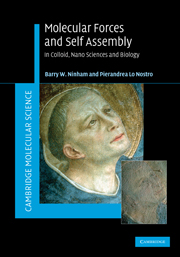Book contents
- Frontmatter
- Contents
- Preface
- Part I Molecular forces
- Part II Self assembly
- 9 Self assembly: overview
- 10 Self assembly in theory and practice
- 11 Bicontinuous phases and other structures: forces at work in biological systems
- 12 Emulsions and microemulsions
- 13 Forces at work: a miscellany of issues
- Index
- References
9 - Self assembly: overview
from Part II - Self assembly
Published online by Cambridge University Press: 06 January 2011
- Frontmatter
- Contents
- Preface
- Part I Molecular forces
- Part II Self assembly
- 9 Self assembly: overview
- 10 Self assembly in theory and practice
- 11 Bicontinuous phases and other structures: forces at work in biological systems
- 12 Emulsions and microemulsions
- 13 Forces at work: a miscellany of issues
- Index
- References
Summary
This and succeeding chapters deal with how it is that molecular forces conspire with the size and shape of molecules called surfactants to associate spontaneously in solution into a myriad multimolecular aggregates. They can be ephemeral entities called micelles. Typical micelles formed by short-chained surfactants exist as entities for times of around 10−5 seconds. On the other hand they can be as long-lived as three or more months. That is so for membrane mimetic long-chained phospholipids that form complex single-walled vesicles and multi-bilayered structures. These self-assembled aggregates provide the organized microstructural scaffolding that forms the basis of biological cell membranes. Self-assembled entities direct biochemical cell traffic.
We have tried to identify conceptual developments in self assembly as they emerged over the past three decades. The result of a great deal of theorizing and experimentation is that some simple rules emerge. These allow the prediction of microstructure, as a function of components, component ratios and physicochemical solution conditions. This, combined with an understanding of how to change molecular forces via specific ion effects, gives some insights into the astonishingly complex background self-organization that occurs in biology. (The genius of DNA, RNA and proteins in biology is not in dispute. What is not generally recognized is that their work takes place within a hidden framework built from and involving the lipids, which are not just passive bystanders.)
- Type
- Chapter
- Information
- Molecular Forces and Self AssemblyIn Colloid, Nano Sciences and Biology, pp. 253 - 292Publisher: Cambridge University PressPrint publication year: 2010
References
- 1
- Cited by



